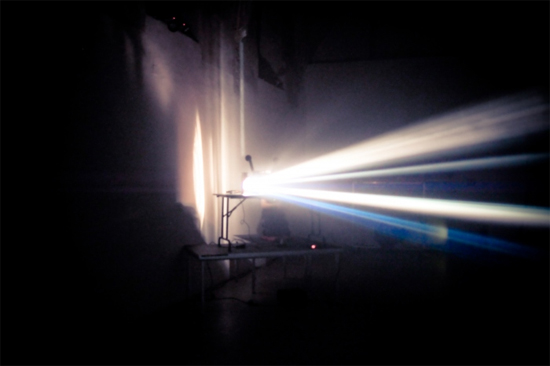There’s been plenty of recent attention on performance and film, what with the Tate’s historically focused Tanks and Spartacus Chetwynd’s nomination for the Turner Prize, but it’s Café Oto that has really championed contemporary work this year. With the relocation of no.w.here’s Unconscious Archives series, Hackney Film Festival’s Expanded Cinema event, and its own programming, tonight’s interweaving of film and sound art practices marks the fifth event of its kind at the venue in as many months.
Greg Pope and Lasse Marhaug begin their séance of slide projectors with a comical air. Two slides depicting the same window – one open, one shut – alternate in a playful dance before Marhaug whips them up, rattling and banging into an unyielding squall. Voices seem to be attempting to speak from the void; choked behind a curtain of gravelly noise. Repetition is key, building a sense of tension and unease from subtly different images. Zooming in and out while changing the speed and rhythm of slide alternations creates a surprising amount of movement, occasionally verging on nauseating. The structured frames of the windows resemble strips of film rubbing against one another, architecture and trees grating against each other in a stuttering dance of life. They summon up cinema’s roots in optical toys of the carnival. The roaring soundtrack sometimes spirals out of control and overpowers the imagery, but for the most part the two complement one another in building a dense exploration of atmosphere and terror.
Jazkamer’s reworking of Lis Rhodes’ Notes From Light Music is an exciting prospect in light of the somewhat tame restaging of Light Music installation at the Tate Tanks. Rhodes’ piece was originally exhibited as a dual screen installation, with two projectors seated at opposing ends of the room, facing one another, and a haze of smoke solidifying their beams into sculptural forms. Black emulsion lines printed across the film are interpreted both visually and as soundtrack, synchronising sound and image. But where the installation was more about space and the spectator’s interaction with light, this iteration has an untamed ferocity. Jazkamer’s soundtrack comes on like the roaring of a jet engine. Sub bass rumbles in the concrete floor, rising into the pit of the stomach before vibrating through the entire body. This is a wholly visceral experience, championing bodily and perceptual sensation over spatial exploration. Perceptual trickery convinces me that teeth are gnashing between lines onscreen and, as movement slows to a crawl, textures crystalize in the emulsion. Again and again in tonight’s work there are echoes of cinema’s beginnings – creating illusions from the magic of pure form and movement.
Finally Pope and Jazkamer team up for a truly astounding performance. Beginning with a glossy darkness of black leader looping smoothly through the projectors, it’s not long until Pope starts methodically tapping the film with sharp implements. Marks in the emulsion build rhythmically into flecks of light. Despite such a focus on materiality and apparatus, Jazkamer’s soundtracking renders these elements unfamiliar by amplifying the projector’s inner workings and the percussive sounds of Pope’s mark making. Vertical and horizontal scratches build structured patterns that recall the abstract works of Len Lye or Oskar Fischinger. Layers of lines mesh to resemble railway tracks – the soundtrack alluding to impending danger. Things intensify as Pope’s aggression builds – now working on the film with a hobby grinder. Thick, textured lines layer in the foreground as the whine of the tool warps the rhythmic sound into a maelstrom of malevolence.
Yet again Paul Sharits’ influence is felt, particularly his mammoth work S:TREAM:S:S:ECTION:S:ECTION:S:S:ECTIONED, where images of flowing water are gradually overlaid with vertical scratches added over its 42 minute runtime. Here, as more and more emulsion is stripped away, organic forms emerge. As if in outright homage to Sharits, the image begins to resemble churning waves that build into a frenzy of melt water tumbling down the screen.
Once again I’m confounded by Café Oto’s theatrical set up, which feels rooted in the very tropes that these artists attempt to quash. Arguably here it works better than previous events of this kind. Nonetheless, standing at the back to view both performance and film seems preferable to sitting staring at a screen. Despite these qualms, it’s great to see a venue actively championing this work and all credit must be given for doing so.


